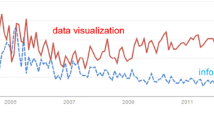Abstract
Visualization of subject structure based on co-word analysis is used to explore the concept network and developmental tendency in certain field. There are many visualization methods for co-word analysis. However, integration of results by different methods is rarely reported. This article addresses the knowledge gap in this field of study. We compare three visualization methods: Cluster tree, strategy diagram and social network maps, and integrate different results together to one result through co-word analysis of medical informatics. The three visualization methods have their own character: cluster trees show the subject structure, strategic diagrams reveal the importance of topic themes in the structure, and social network maps interpret the internal relationship among themes. Integration of different visualization results to one more readable map complements each other. And it is helpful for researchers to get the concept network and developmental tendency in a certain field.







Similar content being viewed by others
References
Amini, M. -R., & Goutte, C. (2010). A co-classification approach to learning from multilingual corpora. Machine Learning, 79(1–2), 105–121.
Borner, K., Chen, C., & Boyack, K. W. (2003). Visualizing knowledge domains. Annual Review of Information Science and Technology, 37(1), 179–255.
Börner, K., Sanyal, S., & Vespignani, A. (2007). Network science. Annual Review of Information Science and Technology, 41, 60.
Chen, C. M. (2005). Searching for clinical evidence in CiteSpace. AMIA Annual Symposium Proceedings, 121–125.
Chen, C. (2006). CiteSpace II: Detecting and visualizing emerging trends and transient patterns in scientific literature. Journal of the American Society for Information Science & Technology, 57(3), 359–377.
Cottrill, C. A., Rogers, E. M., & Mills, T. (2010). Co-citation analysis of the scientific literature of innovation research traditions diffusion of innovations and technology transfer. Journal of Information Science, 36(3), 383–400.
Creswick, N., & Westbrook, J. I. (2010). Social network analysis of medication advice-seeking interactions among staff in an Australian hospital. International Journal of Medical Informatics, 79(6), 116–125.
Cui, L., Liu, W., & Yan, L. (2008). Development of a text mining system based on the co-occurrence of bibliographic items in literature databases. New Technology of Library and Information Service, 24(8), 70–75.
Ding, Y., Chowdhury, G. G., & Foo, S. (2001). Bibliometric cartography of information retrieval research by using co-word analysis. Information Processing & Management, 37(6), 817–842.
Donohue, J. C. (Ed.). (1973). Understanding scientific literatures-A bibliometric approach. Cambridge: The MIT Press.
Everett, M. (Ed.). (2003). Social network analysis. Essex: Textbook at Essex Summer School in SSDA.
Hou, H., Liu, Z., & Chen, Y. (2006). Mapping of science studies: The trend of research fronts. Science Research Management, 27(3), 90–96.
Kostoff, R. N., Stump, J. A., Johnson, D., Murday, J. S., Lau, C. G. Y., & Tolles, W. M. (2006). The structure and infrastructure of the global nanotechnology literature. Journal of Nanoparticle Research, 8(3), 301–321.
Larsen, T. J., & Levine, L. (2005). Searching for management information systems: coherence and change in the discipline. Information Systems Journal, 15(4), 357–381.
Law, J., Bauin, S., Courtial, J.-P., & Whittaker, J. (1988). Policy and the mapping of scientific changer: A co-word analysis of research into environmental acidification. Scientometrics, 14(3–4), 251–264.
Lee, B., & Jeong, Y. -I. (2008). Mapping Korea’s national R&D domain of robot technology by using the co-word analysis. Scientometrics, 77(1), 17.
Lin, S. M., McConnell, P., & Johnson, K. F. (2004). MedlineR: an open source library in R for medline literature data mining. Bioinformatics, 20(8), 3659–3661.
Musgrove, P. B., Binns, R., Page-Kennedy, T., & Thelwall, M. (2003). A method for identifying clusters in sets of interlinking web spaces. Scientometrics, 58(3), 657–672.
Noyons, C. (2005). Science maps within a science policy context. Handbook of Quantitative Science and Technology Research, 237–255.
Ponzi, L. J. (Ed.). (2003). The evolution and intellectual development of knowledge management. New York: Long Island University.
Scott, J., Tallia, A., & Crosson, J. C. (2005). Social network analysis as an analytic tool for interaction patterns in primary care practices. Annals of Family Medicine, 3(5), 443–448.
Van Raan, A. F. J., & Tijssen, R. J. W. (1993). The neural net of neural network research. Scientometrics, 26(1), 169–172.
Vitevitch, M. S. (2008). What can graph theory tell us about word learning and lexical retrieval? Journal of Speech Language and Hearing Research, 51(2), 408–422.
Wagner, C. S., & Leydesdorff, L. (2005). Mapping the network of global science: comparing international co-authorships from 1990 to 2000. International Journal of Technology and Globalisation, 1(2), 185–208.
Wasserman, S., & Faust, K. (1994). Social network analysis: Methods and applications. Cambridge: Cambridge University Press.
Author information
Authors and Affiliations
Corresponding author
Rights and permissions
About this article
Cite this article
Yang, Y., Wu, M. & Cui, L. Integration of three visualization methods based on co-word analysis. Scientometrics 90, 659–673 (2012). https://doi.org/10.1007/s11192-011-0541-4
Received:
Published:
Issue Date:
DOI: https://doi.org/10.1007/s11192-011-0541-4




